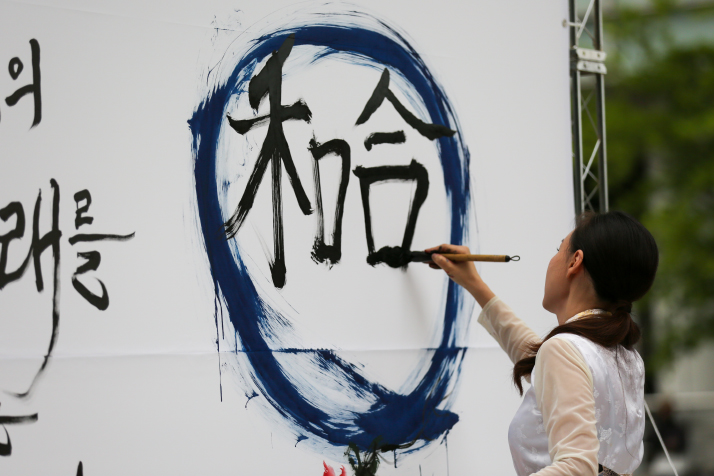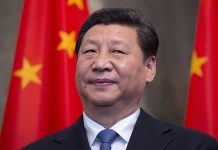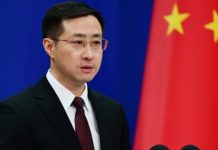
In the face of unprecedented turmoil and change, today’s world grapples with ever more complex difficulties and challenges. This highlights the urgent need for promoting win-win cooperation.
At the 2024 Global Forum on Hehe Culture, which concluded in Taizhou, Zhejiang Province, on November 3, participants from around the world agreed on the importance of fostering global cooperation and mutual understanding through Hehe culture—primarily represented by the principles of “harmony” and “convergence.”
What is Hehe culture?
Hehe culture is believed to have originated on Tiantai Mountain in Taizhou. Around 1,200 years ago in the Tang Dynasty (618-907), the poet Hanshan traveled to Tiantai Mountain to live in seclusion, where he developed a close friendship with the monk Shide at Guoqing Temple. Together, these two figures became known as the “Two Saints of Hehe,” symbolizing the essence of China’s Hehe culture.
Hehe culture is a cherished aspect of traditional Chinese culture. Chinese President Xi Jinping succinctly described Hehe culture in his work Zhejiang, China: A New Vision for Development: “Our ancestors created an incomparable culture, a quintessential part of which is Hehe culture. The first ‘He’ signifies harmony, peace and balance. The second ‘He’ represents convergence, unity and cooperation.”
The concept of “Hehe” has deep roots in Chinese culture. According to a press release from the Global Forum on Hehe Culture, the two characters for “he” can be traced back to ancient Chinese oracle bone and bronze inscriptions.
The essence of Hehe culture is rooted in diversity, tolerance and unity. Irina Bokova, former Director General of UNESCO and one of the first Hehe Culture ambassadors honored at the 2023 edition of the forum, explained in a video message that what makes Hehe culture remarkable is its fusion of ancient Chinese wisdom with modern-day values.
From Hehe to GCI
The Global Forum on Hehe Culture was first launched in Taizhou in 2021. Since its inception, the county has actively developed an international communication platform around the forum, boosting the global visibility and influence of the Chinese civilization, according to the organizers.
This year’s forum, themed Hehe Culture and New Model for Human Progress, saw experts and scholars from both China and abroad recognize the pivotal role of Hehe culture in lifting mutual learning and exchange among global civilizations.
This year, former Prime Minister of Egypt Essam Sharaf, former Undersecretary General of the United Nations Erik Solheim and Piet Steel, who is on the Special Olympics Board of Directors, were named as the latest Hehe Culture ambassadors.
“I believe Hehe culture can play an important role in guiding the efforts aimed at building a community of shared future where everyone can enjoy a prosperous future and be part of a new world order defined by dialogue-driven international relations, and globally governed by rules and genuine multilateralism,” said Sharaf in his remarks at the opening ceremony.
In his speech, Steel emphasized the meaning of “building trust in today’s divided world.” According to him, the concept of Hehe culture is not only about the absence of conflict, but also about “rebalance and coexistence.”
No nation has all the answers to challenges like inequality, climate change and geopolitical tensions that impact everyone, he said. “However, we can find sustainable solutions through true respect for each other and learning from each other,” Steel added.
Many attendees believe Hehe culture and the China-proposed Global Civilizations Initiative (GCI) are linearly connected. The GCI, proposed by Xi in March 2023, underscores the respect for the diversity of civilizations, the common values of humanity, the importance of the inheritance and innovation of civilizations, as well as robust international people-to-people exchanges and cooperation.
Hehe culture and the GCI share similar values, including diversity, equality, gentleness and harmony, Colin Mackerras, professor emeritus at Griffith University in Australia, told Global Times newspaper.
Sharaf told Global Times that Hehe culture is a valuable contribution to the GCI. “The more I think about Hehe culture, the more I feel that if we apply even 50 percent of the six main principles of this culture, the world will flourish and peace will prevail,” he added.

Modern practices
Zhu Yongxin, Vice Chairperson of the National Committee of the Chinese People’s Political Consultative Conference, the country’s top political advisory body, and Executive Vice Chairperson of the Central Committee of the China Association for Promoting Democracy (CAPD) attended the opening ceremony on November 2 and delivered a speech.
The CAPD is one of the country’s eight non-communist parties. Founded in 1945, its membership mainly consists of intellectuals working in the fields of culture, education, publishing and science. Under China’s multi-party cooperation system, non-communist parties participate in state affairs under the leadership of the Communist Party of China (CPC). The CPC and non-communist parties work together and supervise one another.
In his remarks, Zhu stressed the importance of placing people at the center and promoting both Chinese culture as well as the modern civilization of the Chinese nation. He called for strengthening cultural confidence, deepening cultural exchange and advancing the progress of civilizations around the world.
He also advocated for adhering to the philosophy of peace and harmony, upholding the spirit that “our shared future depends on Earth,” and working toward building a community with a shared future for humanity.
In addition to nurturing the development of Chinese culture and society, the ideas embodied in Hehe culture are already making their mark on the global stage.
In his remarks, Solheim stressed the lessons Hehe culture offers to the world today, starting with the unity and harmony between humanity and nature. He commended China for its global leadership in green practices.
Solheim also pointed to the recent agreement between China and India to reduce tensions in the border areas as a practical example of Hehe culture in action. He noted that the two countries’ decision to resolve the issue through joint consultations is an excellent manifestation of Hehe culture and its spirit of harmony.
What’s going on in the Middle East at the moment is the exact opposite of Hehe culture, said Mackerras. “The idea of putting aside things we don’t agree with and focusing on things we do agree with is actually a very good approach.” It’s difficult given the current situation in the Middle East, but negotiation and compromise are still possible, the Australian Sinologist added. –The Daily Mail-Beijing Review news exchange item




